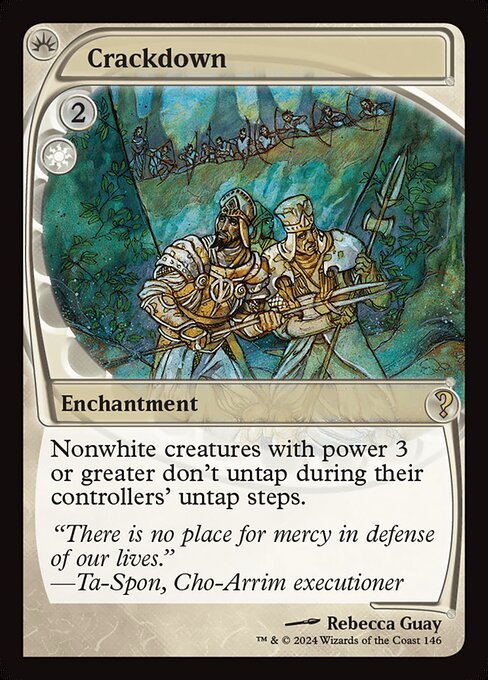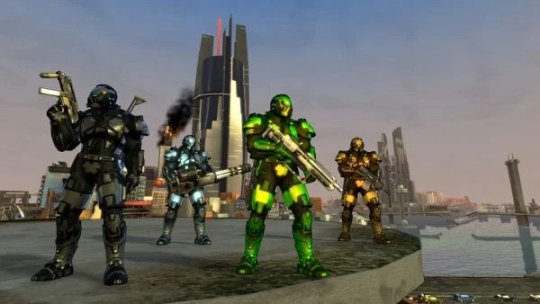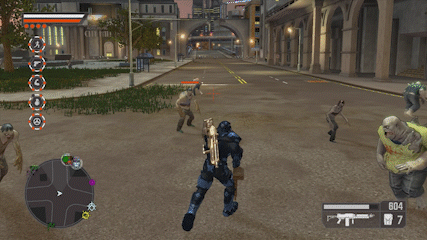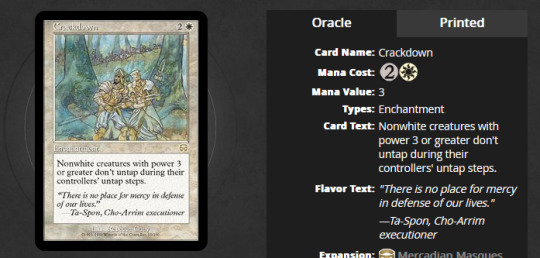#CRACKDOWN
Explore tagged Tumblr posts
Photo

Crackdown
"There is no place for mercy in defense of our lives." —Ta-Spon, Cho-Arrim executioner
Artist: Rebecca Guay TCG Player Link Scryfall Link EDHREC Link
15 notes
·
View notes
Text

Requested by anon
15 notes
·
View notes
Text
N𝗘𝗪: 𝗖𝗼𝗺𝗺𝘂𝗻𝗶𝗰𝗮𝘁𝗶𝗼𝗻𝘀 𝗠𝗶𝗻𝗶𝘀𝘁𝗲𝗿 𝗠𝗶𝗰𝗵𝗲𝗹𝗹𝗲 𝗥𝗼𝘄𝗹𝗮𝗻𝗱 𝘀𝗮𝘆𝘀 𝘁𝗵𝗮𝘁 𝘀𝗵𝗲 𝘄𝗮𝗻𝘁𝘀 𝗮 𝗴𝗿𝗲𝗮𝘁𝗲𝗿 𝗰𝗿𝗮𝗰𝗸𝗱𝗼𝘄𝗻 𝗼𝗻 𝘀𝗼𝗰𝗶𝗮𝗹 𝗺𝗲𝗱𝗶𝗮 — 𝗮𝗻𝗱 𝘁𝗵𝗮𝘁 𝘁𝗵𝗶𝘀 𝗲𝗻𝗱𝗲𝗮𝘃𝗼𝘂𝗿 𝗶𝘀 𝗼𝗻𝗲 𝗼𝗳 𝘁𝗵𝗲 𝗔𝗹𝗯𝗮𝗻𝗲𝘀𝗲 𝗚𝗼𝘃𝗲𝗿𝗻𝗺𝗲𝗻𝘁𝘀 𝘁𝗼𝗽 𝗽𝗿𝗶𝗼𝗿𝗶𝘁𝗶𝗲𝘀 𝗿𝗶𝗴𝗵𝘁 𝗻𝗼𝘄.
“This is one of the highest priorities of this government…
𝑇ℎ𝑒𝑟𝑒 𝑖𝑠 𝑛𝑜 𝑔𝑟𝑒𝑎𝑡𝑒𝑟 𝑝𝑟𝑖𝑜𝑟𝑖𝑡𝑦 𝑓𝑜𝑟 𝑎 𝑔𝑜𝑣𝑒𝑟𝑛𝑚𝑒𝑛𝑡 𝑡ℎ𝑎𝑛 𝑘𝑒𝑒𝑝𝑖𝑛𝑔 𝐴𝑢𝑠𝑡𝑟𝑎𝑙𝑖𝑎𝑛𝑠 𝑠𝑎𝑓𝑒 𝑜𝑛 𝑠𝑜𝑐𝑖𝑎𝑙 𝑚𝑒𝑑𝑖𝑎…” - Australians vs. The Agenda
13 notes
·
View notes
Text

Crackdown
"Activate by targeting 1 face-up monster your opponent controls; take control of that monster. While you control that monster, it cannot attack or activate effects. When that monster leaves the field, destroy this card."
19 notes
·
View notes
Text
Internment
"On January 11, 1940, the DOCR [Defence of Canada Regulations] were amended so as to permit preventive detention, internment before the fact of having committed a crime, ie. article 21. This meant that even though charges for precise offences might not hold up in court, communists could still be interned using vague terms. As well, should the police fail in making a DOCR charge stick, then the freed prisoner could quickly be interned. This situation applied to Ottawans Louis Binder and Arthur Saunders, and to westerners Charles Weir, John McNeil, Pat Lenihan, Alex Miller, and Ben Swankey.
In June, 1940, via DOCR regulation 39C, the Communist Party and related associations were made illegal. These associations included the Young Communist League, the League for Peace and Democracy, which had succeeded the League to Fight War and Fascism, and the Canadian Labour Defence League, as well as several pro-communist, ethnic associations: The Ukrainian Labour-Farmer Temple Association, the Canadian Ukrainian Youth Federation, the Finnish Organization of Canada, the Russian Workers and Farmers Club, the Croatian Cultural Organization, the Hungarian Workers Club, and the Polish People’s Association. Membership in these organizations became illegal; it came to be the grounds most often used for internment.
The first internments took place on June 26, 1940, when Jacob Penner and John Navis, from Winnipeg, and Ottawans Louis Binder and Arthur Saunders were interned. Arrests for internment could follow at any time, but there were more active periods. On June 28 and 29, 1940, nine Montrealers as well as Nicholas Pyndus, from Trois-Rivières, and Robert Kerr and Fergus McKean, each from Vancouver, were interned. On July 8, 1940, seventeen Ukrainian Winnipegers were interned. On August 9, 1940, seven men including five Montrealers were interned. On September 8 and 9, 1940, five more were arrested for internment; on October 10, 1940, four more were interned. The last internment in Hull began on February 10, 1942 when Harvey Murphy was transferred from a Toronto prison.
The cases of Jacob Penner and Pat Sullivan provided important legal precedents about the question of habeas corpus. Were the governments and the police obliged to provide motives for the decision to intern someone, other than article 21 of the DOCR, whereby people presented a danger to the security of the state or the prosecution to the war, or article 39C, whereby people were members of an illegal organization? Jacob Penner was a highly-respected communist and municipal councillor in Winnipeg. After being interned in Kananaskis, Penner’s family hired a lawyer who successfully applied for habeas corpus , however, federal authorities simply held him during the summer of 1940 in an immigration centre in Winnipeg. In August, 1940, a federal appeals judge ruled that habeas corpus did not apply to DOCR article 21. Penner was returned to Kananaskis, providing an important precedent relative to internees from Western Canada.
In central Canada, Pat Sullivan, President of the Canadian Seamen’s Union, was arrested on June 18, 1940. The only explanation for Sullivan’s arrest offered to lawyer J. L. Cohen was Sullivan’s membership in the Communist Party, which the defendant denied. Cohen then launched unsuccessful habeas corpus proceedings in which an Ontario judge ruled that habeas corpus was not relevant since the detainer was not the minister of Justice, and the latter was not required to accept recommendations of a consulting committee considering the detention. Cohen was going to subject this tortured logic of the Ontario Appeals Court judge to the Supreme Court, but decided to desist when the federal government promised to improve the workings of the consulting committees, and to reveal more about the motives for Sullivan’s internment. Nevertheless, after considerable stalling by the minister of Justice, it became clear that the real reasons for Sullivan’s internment were strikes by the Canadian Seamen’s Union in 1938 and 1939, and especially in April, 1940, when Sullivan’s union closed shipping on the Great Lakes from the Lakehead to Montreal. Conciliation following this last strike was proceeding when Sullivan was arrested. Not only did Sullivan’s case show that habeas corpus was of no effect with respect to the internees, it also showed that for some internees, at least for Sullivan, the real motive of internment was union activity.
One suspects the considerable influence of C. D. Howe and his business colleagues working in Ottawa. This was also the case for several of Sullivan’s colleagues within the Canadian Seamen’s Union. A month after Sullivan was arrested, Jack Chapman, union secretary, was arrested while a few days later, Dave Sinclair, editor of the union’s newspaper Searchlight, was arrested for having written about the Sullivan case. Sinclair’s case also demonstrated farcically the incompetence of the RCMP. Sinclair was the nom de plume of David Siglar, a fact he did not hide. During his appeal before the consulting committee, the RCMP presented as evidence activities of someone unknown to Siglar named ‘Segal’, a common name among Jews. Siglar had no idea about whom or what the RCMP was talking not knowing the ‘Segal’ in question, but he did plead guilty to having known several people named ‘Segal’.
The case of Charles Murray, organizer for a fishermen’s union in Lockeport, Nova Scotia, a union affiliated with the Canadian Seamen’s Union, provided another example of how union activities might lead to internment. On June 15, 1940, Nova Scotia’s labour minister, L. D. Currie, sent a letter to Murray stating that:
…You are a communist and as such, deserve to be treated in the same manner as I would be treated if I endeavoured to carry on in Russia as you are doing in Nova Scotia. I warn you now to desist from your efforts to create industrial trouble, and I warn you too that your conduct will from now on be carefully watched and examined, and if I find out that you do not quit this sort of business, then it will be most certainly the worst for you. I am giving you this final word of warning. My advice to you is to get out of Lockeport and stay out…
A few days later, Murray was interned in Petawawa.
Other union leaders received similar fates to those of the leaders of the Canadian Seamen’s Union. Fred Collins had led a successful strike against furniture manufacturers in Stratford, Ontario. James Murphy was the leader of the Technical Employees Association of the Canadian Broadcasting Corporation, and was arrested in the middle of negotiations. Orton Wade was negotiating with meat packing companies in Winnipeg when he was arrested. Bruce Magnuson was a union leader from Port Arthur, where he was local president of the Union of Lumber and Sawmill Workers. Unfortunately, his federal MP was none other than C. D. Howe. In August, 1940, Howe responded to one of Magnuson’s colleagues complaining about the internment of Magnuson.
For very obvious reasons, the normal course of the law must be supplemented by special powers. Otherwise, the effort of the government to suppress fifth-column activities would be of no avail. The now tragic account of fifth-column activities in Norway, the Netherlands, Belgium, and France is ample proof of the inadequacy of the ordinary peacetime machinery of the law in controlling subversive elements… Persons who are considered to be friendly towards Canada’s enemies, or who in any way interfere with Canada’s war effort, are recommended for internment on the strength of evidence assembled by the Force (RCMP).
The motive given for Magnuson’s internment was his membership in the Party, but after the Party began supporting the war effort, Howe wrote to Magnuson in October, 1941:
… do you think that the ends of justice would be served by your release merely because circumstances have caused a change of front by the Communist Party? You were interned because you were out of sympathy with Canada’s war effort, and because you were an active member of an organization which sought to impede that effort.
The case of Clarence Jackson also demonstrated the long arm of Howe. On June 11, 1941, Howe wrote to Justice minister Lapointe, demanding that Jackson be arrested.
Please permit me to call your attention to the activities of one C. S. Jackson, who is undoubtedly one of the most active trouble makers and labour racketeers in Canada today. Jackson has been expelled from the Canadian Congress of Labour as a Communist. He has been responsible for strikes at the R.C.A. Victor plant, the Canadian General Electric plant, and he is now boring in to the Canadian Westinghouse plant at Hamilton. The Westinghouse plant is the most important war manufacturer in Canada, having contracts for anti-aircraft guns, naval equipment, and a wide variety of electrical work important to our production. A strike at Westinghouse would directly stop many branches of our munitions programme. I cannot think why Canada spends large sums for protection against sabotage and permits Jackson to carry on his subversive activities. No group of saboteurs could possibly effect the damage that this man is causing. I feel sure that this is a matter for prompt police action. I suggest that responsible labour leaders can supply any information that you may require on which to base police action.
There is evidence, furthermore, according to the biographer of Jackson, that the Canadian Congress of Labour was complicit in the internment of Jackson. Jackson was arrested on June 23, 1941, but was released from Hull six months later owing to pressure by the American section of his union.
Others were interned for strange reasons. Rodolphe Majeau, a member of the Canadian Seamen’s Union, was interned for having aided Communist candidate Évariste Dubé during the federal election of 1940, when the Party was still legal, an example of a retroactive charge. Scott McLean, a Cape Breton millwright was interned because of dynamite he had in his possession when arrested, dynamite he was using to explode rocks and a manure pile on his farm. John Prossack, from Winnipeg, an elderly Ukrainian charged with membership in the Party, was not in the least involved in politics. Prossack believed that he was interned owing to a bad relationship with his former son-in-law, a paid police informer. Muni Taub, a Montreal tailor left the Party at the end of 1939, one of the many Europeans disgusted at the Hitler-Stalin pact. Nevertheless, motives given for Taub’s internment included his writing for a leftist, Jewish newspaper; his membership in the banned Canadian Labour Defence League, and most of all, Taub’s challenge of the constitutionality of Duplessis’ Padlock Law during the 1930s."
- Michael Martin, The Red Patch: Political Imprisonment in Hull, Quebec during World War 2. Self-published, 2007. p. 124-131
#war measures act#canada during world war 2#defence of canada regulations#anti-communism#communists#communist party of canada#union men#crackdown#internment camps#political repression#academic quote#reading 2023#the red patch#winnipeg#internment operations#mackenzie king government#c. d. howe#dictatorship within democracy#canadian seaman's union#canadian sailors#working class struggle#union organizing#left wing unions
5 notes
·
View notes
Text
The Israeli Fascism Contagion
instagram
#palestine#palestinians#gaza#genocide#censorship#crackdown#witness#israeli atrocities#israeli apartheid#israeli occupation#war crimes#idf terrorists#iof terrorism#iof war crimes#free palestine#free gaza#justice#nurse#aid workers#humanitarian crisis#human rights#right wing extremism#fascism#france#collaborators#zionist terror#jewish terrorism#us weapons#us complicity#france complicity
2 notes
·
View notes
Link
A bad look
#Canada#student activism#universities#U of Alberta#U of Calgary#encampments#Palestine solidarity#militarized police#crackdown#brutality#violence#repression
2 notes
·
View notes
Text
The Legend of Zelda: Tears Of The Kingdom, Isn't Crackdown 2.

Listen, I never really thought that Nintendo would blow the sequel to Breath of the Wild. How could they? When do they blow anything? Even games I actively like from that company tend to actually come out of the oven better than a wide swath of other options in the gaming scene. All that said, I'd be lying if I said there wasn't one part of Tears of the Kingdom that was worrying to me from the start: The Re-Use of the Hyrule map. That worry was unfounded, hell, how do I go further on that? Double unfounded? I bring this worry up, because I've experienced it before in my gaming lifetime, with Crackdown 2. Crackdown isn't a well known franchise anymore, but it was a huge deal for me in 2007. Lots of people only bought the thing because for whatever synergistic reason, it came bundled with Halo 3 beta access, but it was a hell of a game and well worth it's asking price on it's own merits. So naturally, a successful video game warrants a sequel, what interesting new things would the sequel do? What interesting new place would it be set? Nothing and nowhere, are those answers.
Crackdown 2 was set on the same map as the first game, a map with minor alterations, but functionally virtually no changes. To say Crackdown and Crackdown 2 are functionally the same video game being sold twice isn't all that exaggerative of a statement. So naturally because my brain is permanently stained by the late aughts, I was maybe one of five people who held this in my mind when Legend of Zelda Tears Of The Kingdom made mention that it was set in the same Hyrule map as the prior game. I didn't need to be worried. Rather than a re-hash of content, or minor alterations banking on you forgetting the geometry of the landscapes, Hyrule in this game is a wildly different place. Obviously there are the bigger examples, Sky Islands, and those caves that keep killing the hell out of me, but there are small things as well. Things that keep every nook and cranny of this re-used landmass fresh and exciting, when it could have been so much less in the hands of a lesser dev.

You'd think maybe a game with candy colored armor for it's guys would maybe have, idk, a splash of color anywhere else? Things as simple as new and imaginative Korok placement make exploring just as much of a joy as it always was. New towns in odd places, and odd changes to existing towns, keep things that could have easily been a re-hash fresh and new. Hell, to be frank, I've barely scratched the surface of what there is to find on the surface, let alone the caves and up in the sky. I was plainly wrong to worry that Nintendo might overdue it on the re-use of the existing landmass of Hyrule. This is one of the most beautifully handcrafted open worlds I've ever seen, regardless of whether you've seen it's same basic shape 6 years ago. Do yourself a favor and explore this world all over again, there's plenty more to find, and it's not Crackdown 2.
#video games#bread's game journal#funny#game journal#video game#meme#legend of zelda totk#the legend of zelda#legend of zelda tears of the kingdom#tears of the kingdom#totk#totk spoilers#loz totk#zelda#link#zelda totk#hyrule#hryule map#zelda hyrule#crackdown#crackdown 2#xbox#xbox 360#xbox one
7 notes
·
View notes
Text




Crackdown 2 (Xbox 360 2010)
7 notes
·
View notes
Text
youtube
THE PILE PRESENTS: X-Play - The '08 Game Developers Choice Awards | 2/29/08
Get your speech ready!
#The Pile#G4#X-Play#Zero Punctuation#Portal (game)#BioShock#Crackdown#The Legend of Zelda: Phantom Hourglass#Crysis#Magnavox Odyssey#Nintendo#flOw
2 notes
·
View notes
Photo

3 notes
·
View notes
Text
Some help working around Netflix’s password sharing crackdown
The overlords at Netflix have stated that the password sharing requires you to setup a Household. DO NOT DO THIS. Once you set up a main household they will ban all other IP addresses using your password. They are only sending this confirmation of household to TV Devices, roku, playstations, xboxes. HOWEVER if you “do not have a household with a tv.” I.E use a laptop, there should be no message asking you to confirm and all should be good. it also says they will designate a household after 30 days if you do not confirm one, so I am unsure if this will hold, but for now do not set up a “Household” with netflix. If you have any potential long term solutions, GET In the Comments
2 notes
·
View notes
Text

2,000 streams on my new single now on #spotify HELL YEAH! Thank you all so much #muchlove #salute #crack #dudja #rap #hiphop #boombap
#twitter#dudja#rap#soundcloud#youtube#music#hip hop#dope#fire#new#boombayah#boom bap#those hips#hip hip hooray#hip hop music#spotify#spotify artist#crack#crackdown#crackers#obey me crack#fenton crackshell cabrera#hannibal crack#trop crack#crack fic#crackship#crack post#crack rock steady#cracking
1 note
·
View note







